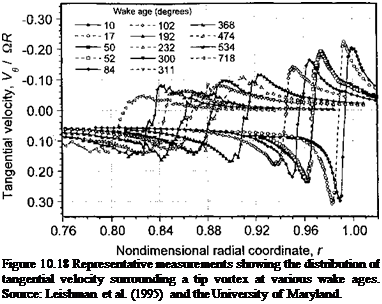Velocity Field
Understanding the velocity field near the tip vortex, the vortex strength (circulation), viscous core radius, as well as how these properties change as the vortex ages, is still a goal of ongoing research. The earliest reported measurements of helicopter rotor tip vortices were performed using hot-wire anemometry (HWA) – see Simons et al. (1966), Cook (1972), Caradonna & Tung (1981), and Tung et al. (1983). However, HWA is limited by spatial resolution, and probe proximity concerns make measurements difficult at early wake ages near the blade tips. Laser Doppler velocimetry (LDV) is an attractive alternative because of the nonintrusive nature of the measurements (apart from seeding) and can alleviate many limitations posed by HWA, such as the physical size of the probe relative to the vortex dimensions, probe interference effects, and wire attrition. However, amongst the main constraints of LDV are optical access, the need to uniformly seed the flow, the need for good periodicity of the flow to allow statistical phase averaging, and a requirement for coincident measurements on all three-components of velocity.
Scully & Sullivan (1972), Sullivan (1973), and Landgrebe & Johnson (1974) have reported some of the first uses of LDV systems to study rotor flows. Thomson et al. (1988) and Mahalingam & Komerath (1998) have made detailed LDV measurements of rotor tip vortices using a 1-D LDV system. A 2-D LDV system was developed by Biggers & Orloff (1975) to investigate some aspects of the wake generated by a two-bladed rotor – see also Biggers et al. (1977a, b). Hoad (1983) has developed a 2-D LDV system with large stand-off distances – see also Elliott et al. (1988) and Althoff et al. (1988). However, 1-D and 2-D LDV systems tend to suffer from reduced spatial resolution because of the elongated measurement volumes, especially with large stand-off distances, and are not always well suited for measuring the small spatial scales and steep velocity gradients found inside vortices. Three-dimensional phase-resolved LDV measurements in rotor wakes, however, have not been possible until recently – see Seelhorst et al. (1994, 1996), McAlister et al. (1995), Leishman et al. (1995), McAlister (1996), Han et al. (1997), and Martin et al. (2001). 3-D systems offer much better spatial resolution if aligned accurately and especially when they are operated in coincident mode, that is, the three component measurements are required to be all statistically correlated.
Representative LDV measurements of the tip vortex induced velocity field are shown in Fig. 10.18 for several wake ages (jrw). The tangential component of velocity has been nondimensionalized by the rotor tip speed, and the distance from the rotational axis has been nondimensionalized by the rotor radius, R. As described previously in Section 2.2.1, the blade tip vortices lie on the boundary of a contracting jet like wake, and the measurements shown in Fig. 10.18 were made on this wake boundary. Inside the wake boundary, note that the slipstream velocity is approximately constant. For increasing fw, the tip vortex convects downward below the rotor and radially inward, and so the velocity signatures shown in
 |
Fig. 10.18 move to the left on the graphs. The results show the basic characteristics of viscous diffusion: vorticity contained in the vortex core diffuses radially outward with time, thereby reducing the peak swirl velocities. The distance between the two velocity peaks shown in Fig. 10.18 can be considered the viscous core diameter.














